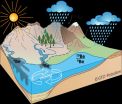NASA sees Tropical Cyclone 01A's winds intensify
2015-06-08
(Press-News.org) Tropical Cyclone 01A has been moving in a northerly direction through the Northern Indian Ocean, and is now curving to the west, moving into the Gulf of Oman. NASA's Aqua satellite and RapidScat instruments gathered imagery and data on the storm. Three days of RapidScat imagery showed how sustained winds increased around the entire storm.
The first tropical cyclone of the Northern Indian Ocean Season was born on Sunday, June 7. Tropical Cyclone 1A developed near 16.3 North latitude and 68.5 East longitude, about 536 nautical miles (616.8 miles/992.7 km) south of Karachi, Pakistan.
RapidScat is a scatterometer instrument that flies aboard the International Space Station and can measure surface winds over the ocean. On June 6, 7, and 8, RapidScat collected wind data on the strengthening tropical storm. RapidScat passed over TC01A on June 6 and gathered wind speed information from 21:44 to 23:16 UTC (5:44 p.m. to 6:16 p.m. EDT). Strongest sustained winds during that time period were near 20 meters per second (mps)/44.4 mph/72 kph) on the western side of the center.
RapidScat wind data on June 7 was taken from 11:37 to 13:09 UTC (7:37 to 9:09 a.m. EDT). By that time sustained winds had extended around the entire center of circulation with maximum sustained winds between 20 and 25 meters per second. On June 8, the strongest winds were not uniform around the entire storm. The weakest winds were on the northern side near 21 mps/46.9 mph/75.6 kph). The strongest maximum sustained winds had increased in the western, southern and eastern quadrants to near 30 mps/67 mph/108 kph).
On June 8 at 09:10 UTC (5:10 a.m. EDT), the Moderate Resolution Imaging Spectroradiometer aboard NASA's Aqua satellite captured a visible image of Tropical Cyclone 01A (TC01A) in the Arabian Sea. The MODIS image showed a concentration of strong thunderstorms surrounding the center, with a slight hook feature northwest of the center.
At that time, TC01A had maximum sustained winds near 40 knots (46 mph/74 kph). TC01A had moved to 18.5 North latitude and 66.4 East longitude, about 396 nautical miles south of Karachi, Pakistan. TC01A was moving to the west-northwest at 8 knots (9.2 mph/14.8 kph).
The Joint Typhoon Warning Center noted that the upper level environment is "moderately favorable with 20 to 25 knots (23 to 28.7 mph/37 to 46.3 kph) of vertical winds shear, offset by good poleward outflow." TC01A is moving under the influence of a strong high pressure area centered over northern India. The clockwise motion of the high pressure area is helping take the tropical cyclone in a northerly direction.
However, in the next day and a half (by June 10), the JTWC noted there will be "a small break in the overall steering environment, causing the system to move very slowly and take on a more northward track through that break. At this time the system will intensify to its peak of 70 knots (80.5 mph/129.6 kph). In the extended forecast, TC01a will continue to take on a more westward track."
TC01A is expected to intensify to hurricane-strength by June 10 and then weaken back to tropical storm status before reaching the entrance of the Gulf of Oman sometime on June 12. The Gulf of Oman separate the country of Oman to the south and Iran to the north.
INFORMATION:
[Attachments] See images for this press release:


ELSE PRESS RELEASES FROM THIS DATE:
2015-06-08
Raising healthy chicks is always a challenge, but in a cold, fish-free Arctic lake, it's an enormous undertaking. Red-throated Loon (Gavia stellata) parents must constantly fly back and forth between their nesting lakes and the nearby ocean, bringing back fish to feed their growing young, and a new study suggests that the chicks grow fast and fledge while they're still small so that they can reach the food-rich ocean themselves and give their parents a break.
Growing chicks must take in enough energy to move around, grow, and maintain their body temperature. The bigger ...
2015-06-08
That weathering has to do with the weather is obvious in itself. All the more astonishing, therefore, are the research results of a group of scientists from the GFZ German Research Center for Geosciences in Potsdam and Stanford University, USA, which show that variations in the weathering of rocks over the past 2 million years have been relatively uniform despite the distinct glacial and interglacial periods and the associated fluctuations in the Earth's climate.
The researchers have observed a most stable behavior in marine sediments, fed year after year through the ...
2015-06-08
Over geologic time, the work of rain and other processes that chemically dissolve rocks into constituent molecules that wash out to sea can diminish mountains and reshape continents.
Scientists are interested in the rates of these chemical weathering processes because they have big implications for the planet's carbon cycle, which shuttles carbon dioxide between land, sea, and air and influences global temperatures.
A new study, published online on June 8 in the journal Nature Geoscience, by a team of scientists from Stanford and Germany's GFZ Research Center for Geosciences ...
2015-06-08
The global movement patterns of all four seasonal influenza viruses are illustrated in research published today in the journal Nature, providing a detailed account of country-to-country virus spread over the last decade and revealing unexpected differences in circulation patterns between viruses.
In the study, an international team of researchers led by the University of Cambridge and the Fred Hutchinson Cancer Research Center, and including all five World Health Organization (WHO) Influenza Collaborating Centres, report surprising differences between the various types ...
2015-06-08
Sydney, Australia: Patterns of peak rainfall during storms will intensify as the climate changes and temperatures warm, leading to increased flash flood risks in Australia's urban catchments, new UNSW Australia research suggests.
Civil engineers from the UNSW Water Research Centre have analysed close to 40,000 storms across Australia spanning 30 years and have found warming temperatures are dramatically disrupting rainfall patterns, even within storm events.
Essentially, the most intense downpours are getting more extreme at warmer temperatures, dumping larger volumes ...
2015-06-08
New York, NY, June 8, 2015 - Professional physician associations consider certain routine tests before elective surgery to be of low value and high cost, and have sought to discourage their utilization. Nonetheless, a new national study by researchers at NYU Langone Medical Center finds that despite these peer-reviewed recommendations, no significant changes have occurred over a 14-year period in the rates of several kinds of these pre-operative tests.
The results are to publish online on June 8, 2015 in JAMA Internal Medicine.
"Our findings suggest that professional ...
2015-06-08
Both statin and nonstatin cholesterol-lowering drugs were associated with memory loss in the first 30 days after patients started taking the medications when compared with nonusers, but researchers suggest the association may have resulted because patients using the medications may have more contact with their physicians and therefore be more likely to detect any memory loss, according to an article published online by JAMA Internal Medicine.
Acute memory loss associated with the use of statins has been described in case reports and case studies, as well as in some studies, ...
2015-06-08
Researchers at University of Helsinki, Finland, and Karolinska Institutet, Sweden, discovered previously uncharacterized mutational patterns in the human regulatory genome, especially in gastrointestinal tract cancers. The study was published in Nature Genetics.
The research led by Academy Professor Lauri Aaltonen and Professor Jussi Taipale, was based on study of more than two hundred whole genomes of colorectal cancer samples. The scientists detected a distinct accumulation of mutations specifically at sites where the proteins CTCF and cohesin bind the DNA.
Both ...
2015-06-08
It's a notion that might be pulled from the pages of science-fiction novel - electronic devices that can be injected directly into the brain, or other body parts, and treat everything from neurodegenerative disorders to paralysis.
It sounds unlikely, until you visit Charles Lieber's lab.
A team of international researchers, led by Lieber, the Mark Hyman, Jr. Professor of Chemistry, an international team of researchers developed a method for fabricating nano-scale electronic scaffolds that can be injected via syringe. Once connected to electronic devices, the scaffolds ...
2015-06-08
Genes linked to creativity could increase the risk of developing schizophrenia and bipolar disorder, according to new research carried out by researchers at the Institute of Psychiatry, Psychology & Neuroscience (IoPPN) at King's College London.
Previous studies have identified a link between creativity and psychiatric disorders such as bipolar disorder, but it has remained unclear whether this association is due to common genes. Published today in Nature Neuroscience, this new study lends support to the direct influence on creativity of genes found in people with schizophrenia ...
LAST 30 PRESS RELEASES:
[Press-News.org] NASA sees Tropical Cyclone 01A's winds intensify


